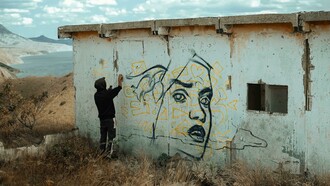Sex Parts, Torsos and Querelle are unique in Warhol’s output for their male erotic content. Isolated from series like Marilyn, Campbell’s and other highly accessible works, Sex Parts is one of Warhol’s most personal works. It belongs to the darker and arguably more profound aspects of his output, closer to the Disaster paintings or Shadows then Flowers or Mickey Mouse. The artist’s female subjects were mostly subjected to his own enlarged portrait format, whereas only male subjects (such as Elvis) were depicted as full-length figures. Sex Parts was a radical compositional departure and along with Torsos, his most focused figurative series. By emphasizing the body through extreme cropping (not unlike classical sculpture) Warhol allows no usual pictorial connection with the model. From antiquity to the modernity of Cezanne, Picasso or Bacon, numerous art historical references come to mind. Typically Warhol never explained himself. When a flustered Bob Collacelo asked what to do about Sex Parts, Warhol quipped “Just call it art…”
Another important inclusion in the collection has an extraordinary history. For Christie’s NY May sale the catalog description of lot 16 Self-portrait and Fright Wig (estimate $30-$40,000,000) uses the words haunting and hypnotic to describe the face of a “terrifying oracle.”
With its demonic grimace reminiscent of a death mask, Anthony d’Offay feared including this image would have been “tempting fate” for his 1986 Warhol show. At d’Offay’s insistence a complete second set of paintings from another source photo were realized, which included Christie’s present lot 16. Whether by accident or design, Warhol had made both a ‘good’ and ‘bad’ version of Self-portrait with Fright Wig.
Warhol made use of the original ‘bad’ Self-portrait in another medium, when he printed sets of T-shirts in black and pink for Keith Haring’s Popshop. After a few sold to several lucky customers, a twist of fate came from a chance visit by Fred Hughes (Warhol’s business manager). A few days later Hughes pulled them from Haring’s Popshop, recognizing that they were valuable works of art strictly meant for the gallery or a museum. Tragically Warhol died the following year, and these astonishing works remained hidden for over 20 years.
If Andy’s beatification has made him a pop saint, his Fright Wigs are his halo. No better picture of the wig exists than in the Self-Portraits executed so closely to his premature death. Like a libertine rock star he disarms the viewer with his cool gaze, while the ubiquitous platinum wig hair shoots out towards infinity. Considering these works posthumously requires a more complex reading than that of just another clever Pop commodity. The black ink of the printed face, floating across the pure white cotton of the T-shaped ground, seems to have been pre-destined for relic status. A significant discovery, considering there is no end in site for the public’s insatiable appetite for all things Warhol.
Sex has no history...but Sex Parts has won its place in Art History. With Sex Parts, we are privy to a personal aspect of Warhol some may find uncomfortably dark and claustrophobic. Sex Parts, whether found to be offensive porn or brilliant art never fails to engage us. Once viewed, Warhol’s voyeurism becomes our own. A final clue might be found in the 1985 work New York Post, where Warhol quoted his friend Madonna’s response to a nude pix scandal. I'M NOT ASHAMED the headline shouts, and Andy might have thought the same.














